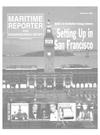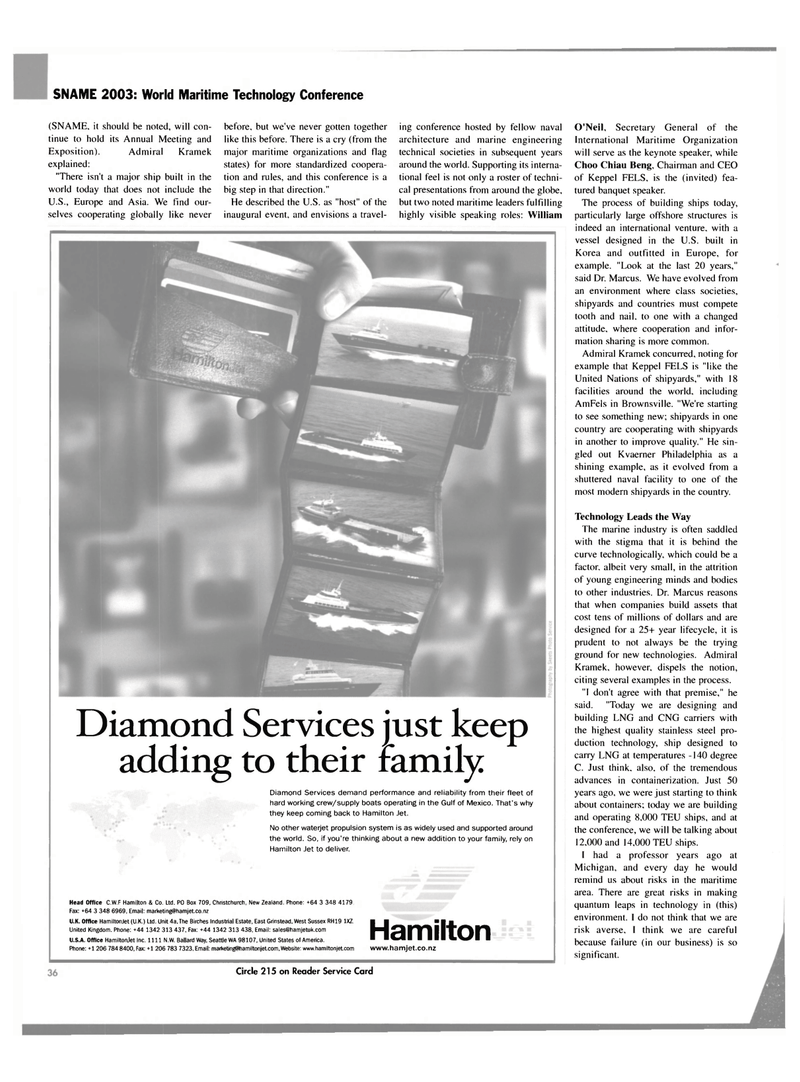
Page 36: of Maritime Reporter Magazine (September 2003)
Read this page in Pdf, Flash or Html5 edition of September 2003 Maritime Reporter Magazine
SNAME 2003: World Maritime Technology Conference
Diamond Services just keep adding to their family
Diamond Services demand performance and reliability from their fleet of hard working crew/supply boats operating in the Gulf of Mexico. That's why they keep coming back to Hamilton Jet.
No other waterjet propulsion system is as widely used and supported around the world. So, if you're thinking about a new addition to your family, rely on
Hamilton Jet to deliver.
Head Office C.W.F Hamilton & Co. Ltd. P0 Box 709, Christchurch, New Zealand. Phone: +64 3 348 4179
Fax: +64 3 348 6969, Email: [email protected]
U.K. Office HamiltonJet (U.K.) Ltd. Unit 4a,The Birches Industrial Estate, East Grinstead, West Sussex RH19 1XZ.
United Kingdom. Phone: +44 1342 313 437, Fax: +44 1342 313 438, Email: [email protected]
U.S.A. Office HamiltonJet Inc. 1111 N.W. Ballard Way. Seattle WA 98107, United States of America.
Phone: +1 206 784 8400, Fax: +1 206 783 7323, Email: mariffitingShamiltonjetcom,Website: www.hamiltonjet.comwww.hamjet.co.nz
Hamilton
O'Neil, Secretary General of the
International Maritime Organization will serve as the keynote speaker, while
Choo Chiau Beng, Chairman and CEO of Keppel FELS, is the (invited) fea- tured banquet speaker.
The process of building ships today, particularly large offshore structures is indeed an international venture, with a vessel designed in the U.S. built in
Korea and outfitted in Europe, for example. "Look at the last 20 years," said Dr. Marcus. We have evolved from an environment where class societies, shipyards and countries must compete tooth and nail, to one with a changed attitude, where cooperation and infor- mation sharing is more common.
Admiral Kramek concurred, noting for example that Keppel FELS is "like the
United Nations of shipyards," with 18 facilities around the world, including
AmFels in Brownsville. "We're starting to see something new; shipyards in one country are cooperating with shipyards in another to improve quality." He sin- gled out Kvaerner Philadelphia as a shining example, as it evolved from a shuttered naval facility to one of the most modern shipyards in the country.
Technology Leads the Way
The marine industry is often saddled with the stigma that it is behind the curve technologically, which could be a factor, albeit very small, in the attrition of young engineering minds and bodies to other industries. Dr. Marcus reasons that when companies build assets that cost tens of millions of dollars and are designed for a 25+ year lifecycle, it is prudent to not always be the trying ground for new technologies. Admiral
Kramek, however, dispels the notion, citing several examples in the process. "I don't agree with that premise," he said. "Today we are designing and building LNG and CNG carriers with the highest quality stainless steel pro- duction technology, ship designed to carry LNG at temperatures -140 degree
C. Just think, also, of the tremendous advances in containerization. Just 50 years ago, we were just starting to think about containers; today we are building and operating 8,000 TEU ships, and at the conference, we will be talking about 12,000 and 14,000 TEU ships.
I had a professor years ago at
Michigan, and every day he would remind us about risks in the maritime area. There are great risks in making quantum leaps in technology in (this) environment. I do not think that we are risk averse, I think we are careful because failure (in our business) is so significant. (SNAME, it should be noted, will con- tinue to hold its Annual Meeting and
Exposition). Admiral Kramek explained: "There isn't a major ship built in the world today that does not include the
U.S., Europe and Asia. We find our- selves cooperating globally like never before, but we've never gotten together like this before. There is a cry (from the major maritime organizations and flag states) for more standardized coopera- tion and rules, and this conference is a big step in that direction."
He described the U.S. as "host" of the inaugural event, and envisions a travel-
Circle 215 on Reader Service Card ing conference hosted by fellow naval architecture and marine engineering technical societies in subsequent years around the world. Supporting its interna- tional feel is not only a roster of techni- cal presentations from around the globe, but two noted maritime leaders fulfilling highly visible speaking roles: William

 35
35

 37
37
